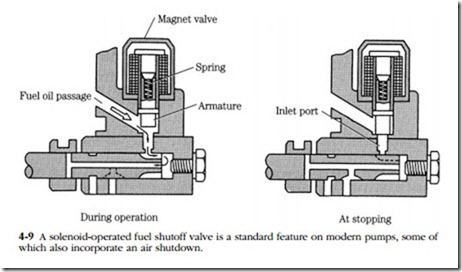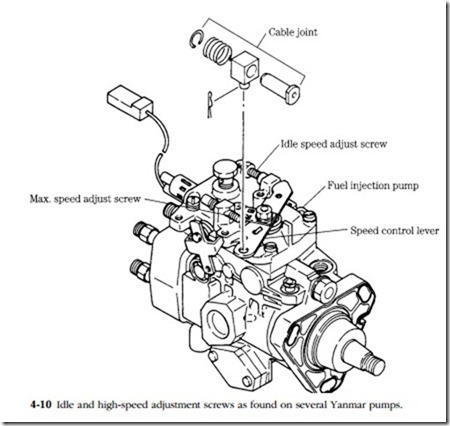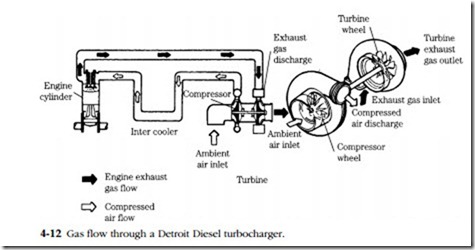Air inlet system
In its most highly developed form, the air inlet system incorporates a turbocharger and exhaust gas recirculation (EGR).
Air filter
Symptoms of filter restrictions are
• Hard starting
• Black exhaust smoke
• Loss of power
• Failure to reach governed speed
• Erratic idle (naturally aspirated engines)
• Turbocharger speed surges and possible oil pullover
Service manuals for vehicle and other small engines merely provide a schedule for changing the air filter. If the operating environment varies, as it does on con- struction sites or during off-road operation, a better approach is to change the ele- ment when the pressure drop across it becomes excessive. Some experimentation with new and used filter elements will be necessary to establish a standard. Pressure drops across new filter elements vary over a range of 2–15 in./H2O. As a general rule, a 50% increase in pressure drop is cause enough to replace the element.
Figure 4-11 illustrates the hookup for measuring pressure drop. The test is made with the engine running at the speed that generates maximum air flow. Air flow peaks at fast idle for naturally aspirated engines and at full power for turbocharged engines.
CAUTION: Do not operate the engine with the air cleaner removed. Unlike spark-ignition (SI) manifolds, which are obstructed by venturis and throttle plates, diesel manifolds open directly (or via expensive compressor wheels) to the combus- tion chambers. A dropped wing nut or, in the case of turbocharged engines, careless fingers, will have dramatic effects.
Positive crankcase ventilation (PCV)
Positive crankcase ventilation valves require routine replacement, since cleaning is rarely effective. The 2.2-L Isuzu used in several GM vehicles demonstrates how complex these systems can become. The liquid component of blowby gases is filtered out and collected in a holding tank for return to the crankcase. A check valve under the tank isolates the sump from PCV vacuum. If this valve clogs, the oil level rises in the tank and is pulled over into the intake manifold to produce clouds of blue smoke.
Exhaust gas recirculation
Failure of the exhaust gas recirculation (EGR) valve or control circuitry flags trouble codes, increases smoke levels dramatically and costs power. When used with EMS, the EGR valve incorporates a position sensor and an actuator that can be cycled with the appropriate scanner.
Turbocharger
What follows is a quick rundown on some of the more frequently encountered turbo faults. See Chap. 9 for more information about these complex machines.
Turbocharger failure has a number of causes, most of them associated with the demands put on the lubrication system by these devices that, in their most modern form attain as much as 400,000 rpm under peak load (Fig. 4-12). Momentary interruptions in the oil supply, which might occur during initial startup after an oil change
or during sudden acceleration immediately after a cold start, destroys the bearings. If the engine is run hard and abruptly shut down, oil trapped in the turbocharger case absorbs heat from the turbine and carburizes into an abrasive. Many EM systems can be programmed to eliminate cold, wide-open-throttle starts and hot shutdowns.
Other problems include carbon and scale accumulations on the wheels, exhaust- side leaks (caused by thermal expansion of the piping), pressure-side leaks (often at the manifold-to-block gasket), and blade-tip erosion. A faulty air filter will “dust” the compressor wheel, giving it a satiny appearance.
Some malfunctions—noise, excessive bearing clearances, cracked exhaust plumbing—obviously involve the turbocharger. A fall off in power, sooty exhaust, low or erratic turbo boost may have causes outside of the unit. Before assuming that the turbocharger is a fault, check the fuel system with particular attention to the injectors, and verify that the pressure drop across the air filter element is within spec- ification. Carefully inspect the turbocharger oil and vacuum lines. And, of course, you need to retrieve the trouble codes. Many EMS blowers incorporate variable geometry, so that boost comes on early during the rpm curve. Malfunctions will flag trouble codes associated with abnormal levels of boost and actuator failure.
Start the engine and listen to the sound the turbocharger makes. With a little practice you will be able to distinguish the shrill sound of air escaping between the compressor and engine and the sound of exhaust leaks, which are pitched at a lower register. If the sound changes in intensity, check for a clogged filer, loose sound- deadening material in the intake duct, and dirt/carbon accumulations on the compressor wheel and housing. A stethoscope will amplify any mechanical noise.



